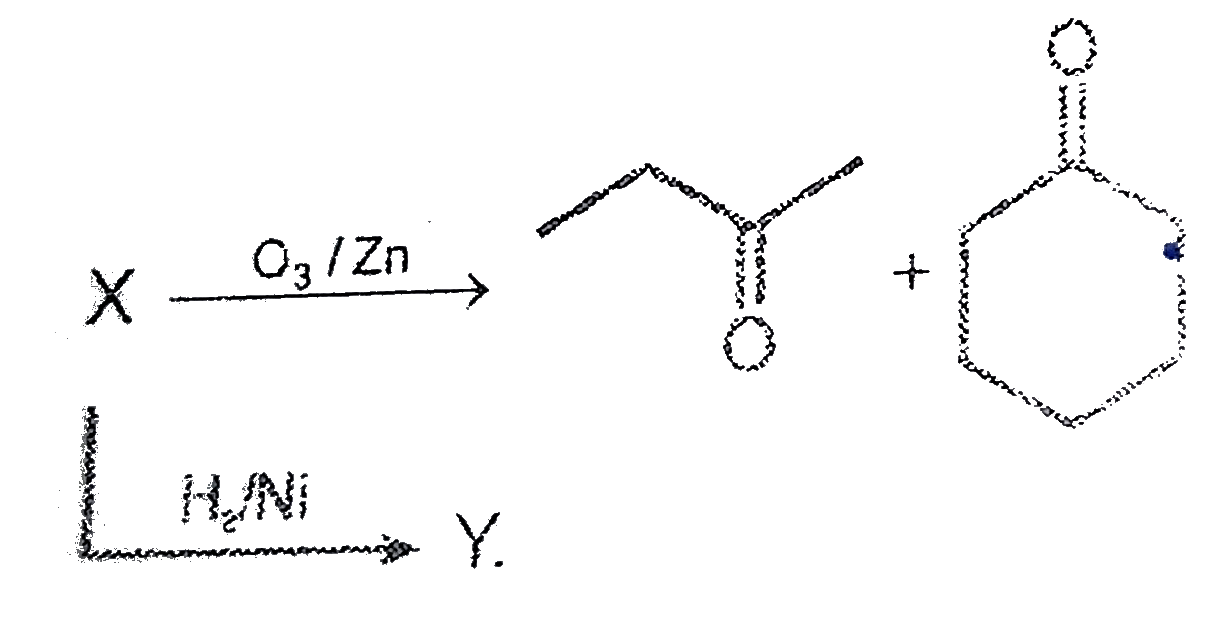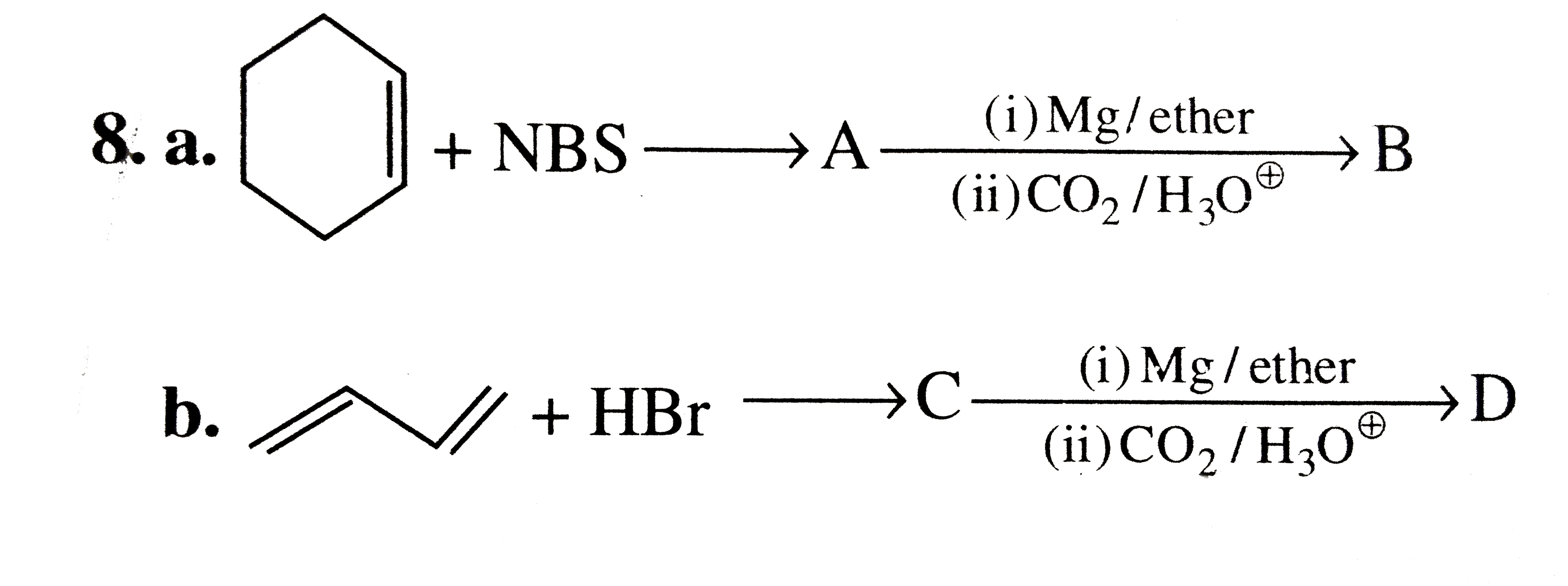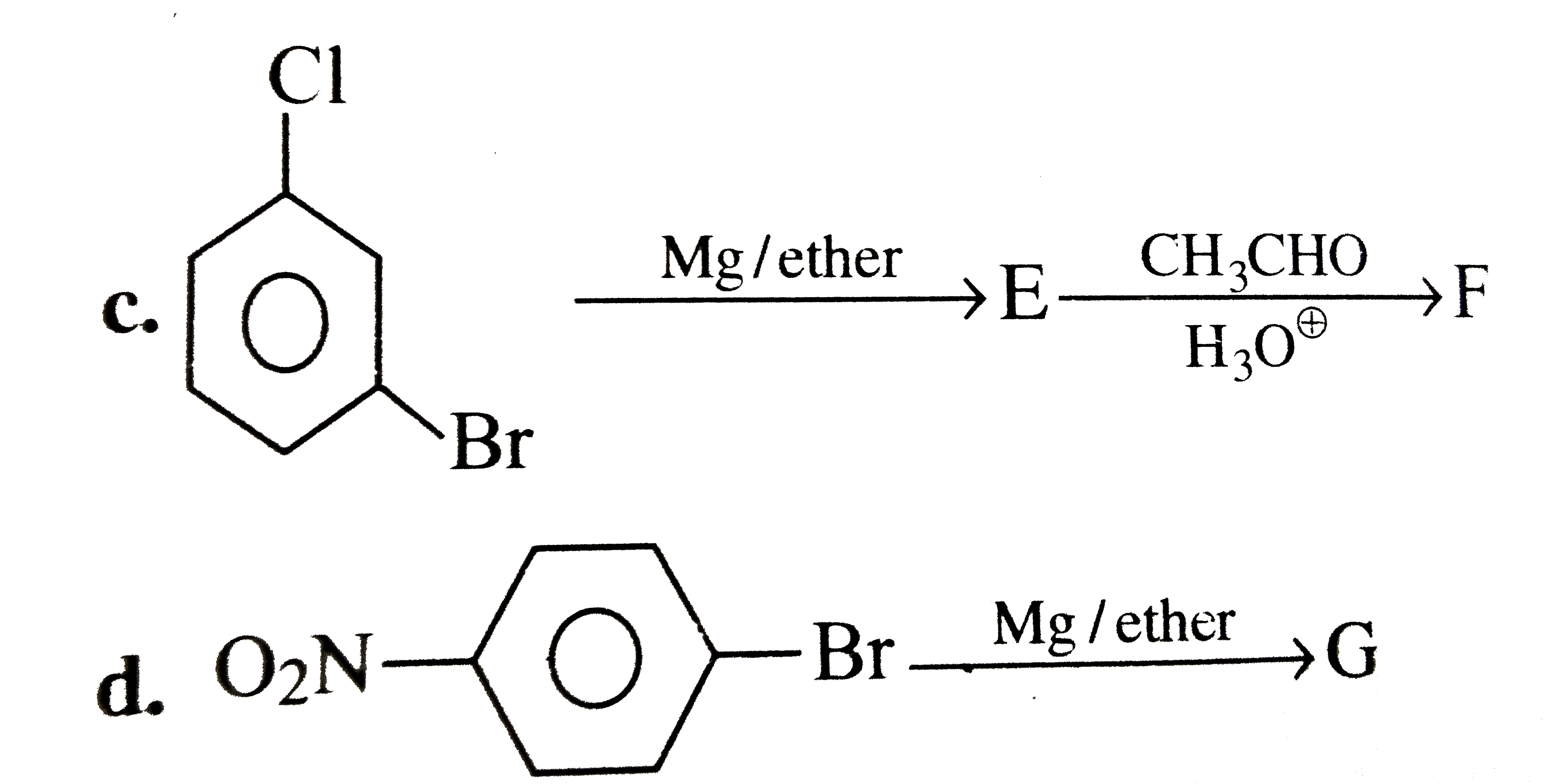Four isomeric optically active compounds NaHCO3−−−−−→CO2(g)(A,B,C,D)(C4H8O3)
Compound (A)LAH−−→(E) (Archiral compound)
Compound (B)KMnO4−−−−−→orCrO3 Inert to oxidation.
Compound (C)−−−−−−−−→NaOI/H3O⊕CHI3(Yellowppt.)+Compound(F).
Compound (B) is :
(I)
(II)
(III)
(IV)
The correct Answer is:D
To solve the problem, we need to identify compound B from the given information about the four isomeric optically active compounds with the formula C4H8O3. We will analyze the information step by step.
Step 1: Determine the Degree of Unsaturation (DU)
The formula for calculating the degree of unsaturation (DU) is:
DU=(2×number of Carbons)+2−number of Hydrogens2
For the compound C4H8O3:
- Number of Carbons (C) = 4
- Number of Hydrogens (H) = 8
Substituting these values into the formula:
DU=(2×4)+2−82=8+2−82=22=1
Step 2: Analyze the Implications of DU
A degree of unsaturation of 1 indicates that there is either one double bond or one ring present in the structure. Given that we are dealing with carboxylic acids and their derivatives, it is likely that one of the functional groups is a carboxylic acid (-COOH).
Step 3: Identify Compound A
From the information given, compound A reacts with LAH (Lithium Aluminium Hydride) to form an achiral compound. This suggests that compound A contains a carbonyl group (C=O) that can be reduced to an alcohol.
Assuming compound A has a structure like:
- CH3-CH(OH)-COOH (a chiral center)
When reduced with LAH, it could yield:
- CH3-CH2-CHOH (an achiral compound)
Step 4: Identify Compound B
Compound B is described as being inert to oxidation. This typically indicates that compound B is likely a primary alcohol or a ketone that does not have any hydrogen atoms on the carbon adjacent to the carbonyl group that could be oxidized.
Possible structures for compound B could include:
- A structure such as CH3-CH(OH)-OCH3 (methoxy group) or CH3-CH2-COOH (where the alcohol is not oxidizable).
Step 5: Conclusion for Compound B
Given that compound B is inert to oxidation, it is likely a structure that includes a methoxy group and a carboxylic acid group. Therefore, compound B can be represented as:
Compound B: CH3−CH(OH)−COOH
Final Answer
Compound B is likely to be a structure that is a methoxy derivative of a carboxylic acid, specifically:
Compound B: Methoxyacetic acid(CH3−COOH)
The formula for calculating the degree of unsaturation (DU) is:
- Number of Carbons (C) = 4
- Number of Hydrogens (H) = 8
A degree of unsaturation of 1 indicates that there is either one double bond or one ring present in the structure. Given that we are dealing with carboxylic acids and their derivatives, it is likely that one of the functional groups is a carboxylic acid (-COOH).
From the information given, compound A reacts with LAH (Lithium Aluminium Hydride) to form an achiral compound. This suggests that compound A contains a carbonyl group (C=O) that can be reduced to an alcohol.
- CH3-CH(OH)-COOH (a chiral center)
- CH3-CH2-CHOH (an achiral compound)
Compound B is described as being inert to oxidation. This typically indicates that compound B is likely a primary alcohol or a ketone that does not have any hydrogen atoms on the carbon adjacent to the carbonyl group that could be oxidized.
- A structure such as CH3-CH(OH)-OCH3 (methoxy group) or CH3-CH2-COOH (where the alcohol is not oxidizable).
Given that compound B is inert to oxidation, it is likely a structure that includes a methoxy group and a carboxylic acid group. Therefore, compound B can be represented as:
Compound B is likely to be a structure that is a methoxy derivative of a carboxylic acid, specifically:
Topper's Solved these Questions
- CARBOXYLIC ACIDS AND THEIR DERIVATIVESBOOK - CENGAGE CHEMISTRY ENGLISHCHAPTER - CARBOXYLIC ACIDS AND THEIR DERIVATIVESEXERCISE - Exercises (Multiple Correct)
34 Videos
- CARBOXYLIC ACIDS AND THEIR DERIVATIVESBOOK - CENGAGE CHEMISTRY ENGLISHCHAPTER - CARBOXYLIC ACIDS AND THEIR DERIVATIVESEXERCISE - Exercises (Singlecorrect)
64 Videos
- CARBOXYLIC ACIDS AND THEIR DERIVATIVESBOOK - CENGAGE CHEMISTRY ENGLISHCHAPTER - CARBOXYLIC ACIDS AND THEIR DERIVATIVESEXERCISE - Exercises (Subjective)
19 Videos
- BIOMOLECULESBOOK - CENGAGE CHEMISTRY ENGLISHCHAPTER - BIOMOLECULESEXERCISE - Exercises Archives (Analytical And Descriptive)
8 Videos
- CHEMICAL KINETICSBOOK - CENGAGE CHEMISTRY ENGLISHCHAPTER - CHEMICAL KINETICSEXERCISE - Archives Subjective
23 Videos
Similar Questions
Knowledge Check
An optically active compound 'X' having molecular formula C4H8O3 . It evolves CO2 with NaHCO3. ' X 'on reaction with LiAlH4 give achiral compound. 'X' is:
A B
B C
C D
D
Compound (A)1molof−−−−−−→HIO4

The compound (A) is:
View SolutionCompound (A)(C6H8)[o]−−→ Malonic acid only. Identify compound (A).
View Solution (i)CH3CHO−−−−−−−→(ii)H3O+ (A) HBr−−→ (B)
(i)CH3CHO−−−−−−−→(ii)H3O+ (A) HBr−−→ (B)
The compounds (A) and (B)
View SolutionPhenyl isocyanide + Benzyl magnesium bromide 1.EtherΔ−−−−−→2.H3O⊕(A). The compound (A) is :
View SolutionXO3/Zn−−−→ ,

The IUPAC name of compound Y is :
View Solution(a)

(b)
( e) PhMgBrO2−−−→H3O⊕?
(f) Phenol+RMgI→?.
View SolutionC6H10NBS−−→(X)Mgether−−−−→(Y)CH3CN−−−−→H3O+(Z)
The compound (Z) is
View Solution
